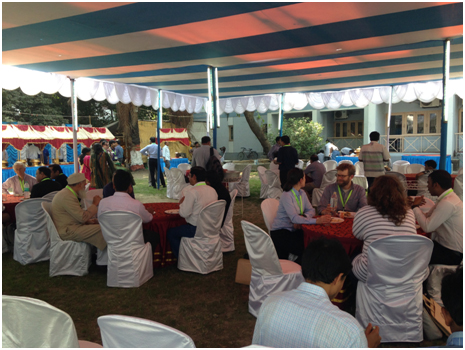
Workshop participants from the USA (left to right): Richard Smith, Soutir Bandyopadhyay, Sujit Ghosh, Ander Wilson, Veronica Berrocal, Dorit Hammerling, Stacey Alexeeff, Doug Nychka, Kiros Berhane.
The following was written by Stacey Alexeeff, NSF postdoctoral fellow.
Thirty hours of travel brought me from Colorado to New Jersey to Mumbai, and finally to Kolkata, India for the VI-MSS Workshop on Environmental Statistics. Jointly organized by the Indian Statistical Institute and SAMSI, the workshop participants included researchers and professors from across India and the US. Some of us, like myself, were traveling to India for the first time. Luckily, the other participants who had lived in Kolkata took some time to make us feel comfortable. Soutir Bandyopadhyay brought a few of us to his favorite traditional Indian restaurant to enjoy a delicious meal the night we arrived.
The workshop was designed to bring together researchers from both the US and India to address questions in environmental statistics. The talks included a broad range of environmental topics from soil contamination to air pollution to rainfall predictions. The conference organizers put in a great deal of effort to showcase work across different institutions of India. This gave a nice breadth to the talks. The poster session gave us all a chance to mingle, and it was a great to have change of pace and get out of out seats for awhile.
I enjoyed walking through the Indian Statistical Institute campus. I got a kick out of names of the buildings, each named after a famous statistician. Our workshop was held in Kolmogorov Hall. Most surprising was finding out there was a dinosaur fossil museum in the building right across from where we were meeting, and getting an impromptu tour. Personally, I enjoyed talking with the other conference participants, and I now feel a certain kinship with the many statisticians who I have met who in the US who spent part of their educational training at ISI.








